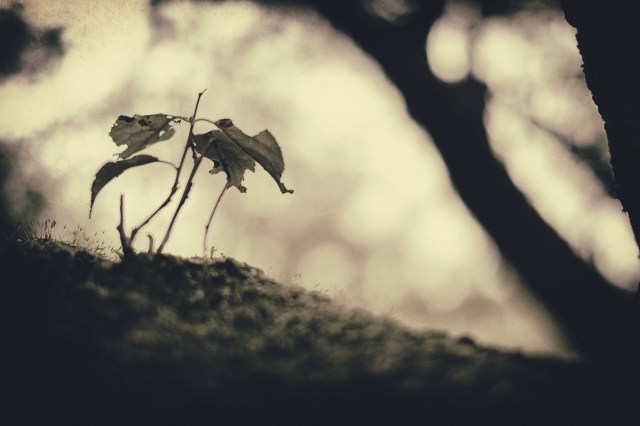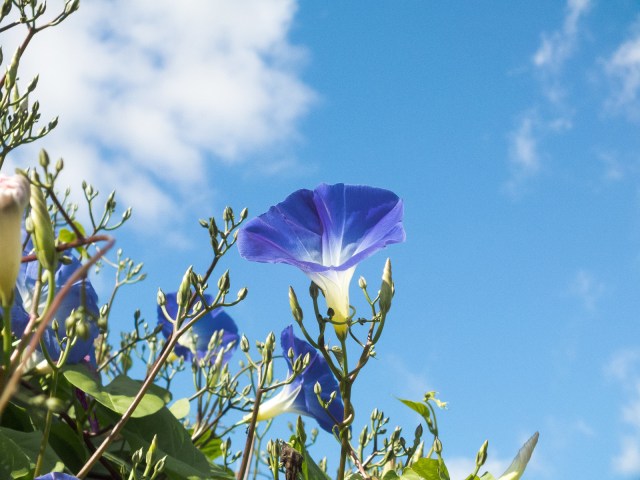
Would a rose by any other name be as dead?
“I’m going to learn the Japanese language!” You announce to yourself, bright-eyed and determined, a fire in your heart and a world of knowledge ahead of you. You studiously pore over hiragana tables, then drill each and every katakana into your head. You learn that Japanese is structured differently from English, that the verb tends to come after the subject and object rather than between them. You tackle a mountain of kanji. Maybe you even find some friends to talk in Japanese with and learn the ebbs and flows of conversation.
Feeling good about yourself, you gesture to a vase filled with ailing morning glories. “Asagao ga kareta.” The morning glories have withered. Right?
…Right?
Wrong! When you address morning glories, or asagao, the correct term to use is shibomu. It also means “to wither”, but has a shriveling, deflating nuance to it.
▼ Here’s a fully blooming morning glory to make you feel better.
As with many aspects of the Japanese language, many native speakers will be far too polite to correct you on the finer points of funereal flower terminology, especially as kareru (the catch-all verb for “wither” or “die” when applied to plants) makes perfect sense in context. But for perfectionists who wish to speak flawless, top-tier Japanese it’s yet another thorn in their side.
YouTuber Artur, who is Latvian but produces content primarily in Japanese, lamented the extent of his withering woes in the following tweet:
他の言語だと『花が枯れる』という表現はそんなに多くないと思うんだけど、日本語の『花が枯れるの表現多すぎ問題』に直面してラトビア人泣いてる。
— アルトゥル📛日本推しラトビア人 (@ArturGalata) March 12, 2021
桜⇒散る
梅⇒こぼれる
椿⇒落ちる
朝顔⇒しぼむ
菊⇒舞う
牡丹⇒崩れる
ま…待ってくれ…
日本人のみんな…
そなた達の語彙力は底なし沼か?
“I feel that other languages don’t have anywhere near as many ways to say the phrase ‘the flower has died’, but the conundrum of having far too many ways to say ‘the flower has died’ in Japanese would reduce a Latvian native to tears.
Cherry blossom ⇒ chiru (falls)
Plum blossom ⇒ koboreru (spills)
Common camellia ⇒ ochiru (drops)
Morning glory ⇒ shibomu (shrivels)
Chrysanthemum ⇒ mau (flutters)
Tree peony ⇒ kuzureru (crumbles)S…Stop, please…
Japanese people…
Is the ravine of your vocabularies truly this bottomless…?”
Each of the verbs listed above—chiru, koboreru, ochiru, shibomu, mau, kuzureru—technically means “to die” in the context of its given flower. In Japanese, just as much importance is given to when a flower shuffles off the mortal coil as to when it blooms, which is why these dying words are so incredibly descriptive—while a cherry blossom falls in death, you wouldn’t describe the ground-rooted morning glory to “fall”. Instead it shrinks in on itself, loses its vivid color, and dies in a tight bundle, so the shriveling aspect of shibomu feels much more appropriate. Likewise, it just feels wrong to describe the fluttering free-fall of dead cherry blossoms as them shriveling.
Common camellia flowers drop dramatically in death, while plum blossoms—similar to cherry blossoms— will spill down from the branches in a shower. The fluttering of chrysanthemums refers to how their sheaves of delicate, willowy petals detach as the plant sickens. Lastly, the tree peony crumbles when it dies in every sense of the word. It loses its pallor, the petals disintegrate. This typically signifies that the branch it grew on needs to be pruned.
Artur apparently came across this unique quirk of language when studying up on the transient art of wabi-sabi; when he realized that blossoms can chiru but autumnal leaves will kareru, he was astounded by the depth and significance of the language involved.
▼ “Japan’s four seasons, especially spring and autumn, are full of wabi-sabi experiences.”
最近は【侘び寂び】を勉強しているのですが、花が散るや紅葉が枯れるなど本当に奥が深いなと驚いてるラトビア人です。
— アルトゥル📛日本推しラトビア人 (@ArturGalata) March 12, 2021
日本の四季、特に春と秋はワビサビを感じる事が多いですね。
🎬【動画】わびさびに取り憑かれた外国人、その本性とは!?
▶https://t.co/l4Lxkov9I3 pic.twitter.com/4CbYr10rxn
The sheer level of descriptive death verbs came as a shock to his many native Japanese fans, as well. The Twitter thread was filled with amusement at how many different terms there were, as well as respect for his determination to learn them all.
“I’m Japanese myself, but even I was astonished at the breadth of phrases. The Japanese language is deep, indeed…”
“Common camellias make a very meaty THUD when they fall, so in the warring Sengoku period, they were considered bad omens. The flower falling with a THUD… It sounds like a head, you know?”
“I don’t think every single Japanese person has these words for flowers dying in their vocabulary, but there sure are a lot.”
“I never knew the terms for plum blossom, chrysanthemum, and tree peony!”
Check out Artur’s YouTube channel for more passionate discoveries like this one, and we have a few things we can teach you, too!
Source: Twitter/@ArturGalata via My Game News Flash
Top image: Pakutaso
Insert image: Pakutaso
● Want to hear about SoraNews24’s latest articles as soon as they’re published? Follow us on Facebook and Twitter!


 Japan’s “camellia crepes” look blooming delicious 【Photos】
Japan’s “camellia crepes” look blooming delicious 【Photos】 Potted mini sakura trees are perfect for everyone who missed cherry blossom season this year
Potted mini sakura trees are perfect for everyone who missed cherry blossom season this year Korean pastry chef crafts incredibly realistic floral cakes using just buttercream 【Pics】
Korean pastry chef crafts incredibly realistic floral cakes using just buttercream 【Pics】 Fallen cherry blossoms make gorgeous “sakura carpet” at Hirosaki Park 【Photos】
Fallen cherry blossoms make gorgeous “sakura carpet” at Hirosaki Park 【Photos】 Sharpening these colored pencils will give you beautiful flower petals
Sharpening these colored pencils will give you beautiful flower petals How to order snacks on a Shinkansen bullet train in Japan
How to order snacks on a Shinkansen bullet train in Japan Hello, cosmetics! Clinique teams up with Hello Kitty this summer for first-time collaboration
Hello, cosmetics! Clinique teams up with Hello Kitty this summer for first-time collaboration Burger King Japan suddenly adds Dr. Pepper and Dr. Pepper floats to its menu nationwide
Burger King Japan suddenly adds Dr. Pepper and Dr. Pepper floats to its menu nationwide Demon Slayer: Kimetsu no Yaiba gets new roller coaster attractions and food at Universal Studios Japan
Demon Slayer: Kimetsu no Yaiba gets new roller coaster attractions and food at Universal Studios Japan New samurai glasses are Japan’s latest weird must-have souvenir
New samurai glasses are Japan’s latest weird must-have souvenir New Nintendo Lego kit is a beautiful piece of moving pixel art of Mario and Yoshi【Photos】
New Nintendo Lego kit is a beautiful piece of moving pixel art of Mario and Yoshi【Photos】 Nintendo history you can feel – Super NES, N64, and GameCube controllers become capsule toys
Nintendo history you can feel – Super NES, N64, and GameCube controllers become capsule toys Japan’s new difficult-to-drink-from beer glass protects your liver, but it’s a brutal experience
Japan’s new difficult-to-drink-from beer glass protects your liver, but it’s a brutal experience 10 things you should buy at 7-Eleven in Japan
10 things you should buy at 7-Eleven in Japan McDonald’s adds new watermelon frappe and fruity macaron to its menu in Japan
McDonald’s adds new watermelon frappe and fruity macaron to its menu in Japan “The most Delicious Cup Noodle in history” – Japan’s French Cup Noodle wins our heart【Taste test】
“The most Delicious Cup Noodle in history” – Japan’s French Cup Noodle wins our heart【Taste test】 Starbucks releases a cute Frappuccino and Unicorn Cake…but not in Japan
Starbucks releases a cute Frappuccino and Unicorn Cake…but not in Japan Kyoto Tower mascot termination reveals dark side behind cute Japanese characters
Kyoto Tower mascot termination reveals dark side behind cute Japanese characters McDonald’s Japan’s Soft Twist Tower: A phantom ice cream only sold at select branches
McDonald’s Japan’s Soft Twist Tower: A phantom ice cream only sold at select branches Yabai Ramen: What makes this Japanese ramen so dangerous?
Yabai Ramen: What makes this Japanese ramen so dangerous? Finally! Nintendo Japan expands Switch 8-bit controller sales to everybody, Online member or not
Finally! Nintendo Japan expands Switch 8-bit controller sales to everybody, Online member or not Japanese government wants to build luxury resorts in all national parks for foreign tourists
Japanese government wants to build luxury resorts in all national parks for foreign tourists To combat declining birth rate, Japan to begin offering “Breeding Visas” to foreigners
To combat declining birth rate, Japan to begin offering “Breeding Visas” to foreigners Studio Ghibli releases anime heroine cosplay dresses that are super comfy to wear
Studio Ghibli releases anime heroine cosplay dresses that are super comfy to wear Woman charged for driving suitcase without a license in Osaka
Woman charged for driving suitcase without a license in Osaka Studio Ghibli unveils My Neighbour Totoro miniature house model
Studio Ghibli unveils My Neighbour Totoro miniature house model Kyoto experiencing problems with foreign tourists not paying for bus fares, but not on purpose
Kyoto experiencing problems with foreign tourists not paying for bus fares, but not on purpose Fighting mild hunger with a Japanese soda that turns into jelly in the stomach【Taste test】
Fighting mild hunger with a Japanese soda that turns into jelly in the stomach【Taste test】 Studio Ghibli’s Howl’s Moving Castle tapestry unveiled in Japan for first time
Studio Ghibli’s Howl’s Moving Castle tapestry unveiled in Japan for first time McDonald’s new Happy Meals offer up cute and practical Sanrio lifestyle goods
McDonald’s new Happy Meals offer up cute and practical Sanrio lifestyle goods Sales of Japan’s most convenient train ticket/shopping payment cards suspended indefinitely
Sales of Japan’s most convenient train ticket/shopping payment cards suspended indefinitely Sold-out Studio Ghibli desktop humidifiers are back so Totoro can help you through the dry season
Sold-out Studio Ghibli desktop humidifiers are back so Totoro can help you through the dry season Japanese government to make first change to romanization spelling rules since the 1950s
Japanese government to make first change to romanization spelling rules since the 1950s Foreigner’s request for help in Tokyo makes us sad for the state of society
Foreigner’s request for help in Tokyo makes us sad for the state of society Ghibli founders Toshio Suzuki and Hayao Miyazaki contribute to Japanese whisky Totoro label design
Ghibli founders Toshio Suzuki and Hayao Miyazaki contribute to Japanese whisky Totoro label design Doraemon found buried at sea as scene from 1993 anime becomes real life【Photos】
Doraemon found buried at sea as scene from 1993 anime becomes real life【Photos】 Tokyo’s most famous Starbucks is closed
Tokyo’s most famous Starbucks is closed Princesses, fruits, and blacksmiths: Study reveals the 30 most unusual family names in Japan
Princesses, fruits, and blacksmiths: Study reveals the 30 most unusual family names in Japan McDonald’s Japan celebrates cherry blossom season with new cherry frappe and mocha drinks
McDonald’s Japan celebrates cherry blossom season with new cherry frappe and mocha drinks Sakura in Japan 2019: The best spots for hanami cherry blossom viewing
Sakura in Japan 2019: The best spots for hanami cherry blossom viewing Mark your calendars for the return of Japan’s popular cherry blossom-inspired beer
Mark your calendars for the return of Japan’s popular cherry blossom-inspired beer Sakura season officially declared in Tokyo, earliest start to hanami on record
Sakura season officially declared in Tokyo, earliest start to hanami on record Couldn’t catch the cherry blossoms in full bloom? We’ve got a unique idea for you!
Couldn’t catch the cherry blossoms in full bloom? We’ve got a unique idea for you! Step inside a mystical, dazzling display of illuminations at the Flower Garden of Lights
Step inside a mystical, dazzling display of illuminations at the Flower Garden of Lights These stunningly beautiful seasonal pink flowers from Japan are NOT cherry blossoms【Photos】
These stunningly beautiful seasonal pink flowers from Japan are NOT cherry blossoms【Photos】 Seven places that aren’t Starbucks where you can get delicious sakura cherry blossom drinks in Japan
Seven places that aren’t Starbucks where you can get delicious sakura cherry blossom drinks in Japan Sakura train ride plays out like a magical scene from a Japanese anime movie
Sakura train ride plays out like a magical scene from a Japanese anime movie Gorgeous Japanese sakura and Mt. Fuji drinkware reacts to cold temperatures with beauty
Gorgeous Japanese sakura and Mt. Fuji drinkware reacts to cold temperatures with beauty Sakura doughnuts depict life cycle of cherry blossoms at Mister Donut in Japan
Sakura doughnuts depict life cycle of cherry blossoms at Mister Donut in Japan Love blooms after loss: Japanese netizen commemorates grandparents’ romance, gardening skills
Love blooms after loss: Japanese netizen commemorates grandparents’ romance, gardening skills Sakura 2017: Japan Meteorological Corporation releases first national cherry blossom forecast
Sakura 2017: Japan Meteorological Corporation releases first national cherry blossom forecast Even more Starbucks sakura cherry blossom drinkware! Round 2 for 2021 features Spring Bloom theme
Even more Starbucks sakura cherry blossom drinkware! Round 2 for 2021 features Spring Bloom theme Japanese coffee chain brings in spring with sakura-scented ground and drip coffee
Japanese coffee chain brings in spring with sakura-scented ground and drip coffee Gorgeous matcha ajisai parfait ice cream bars appear just in time for hydrangea season
Gorgeous matcha ajisai parfait ice cream bars appear just in time for hydrangea season
Leave a Reply